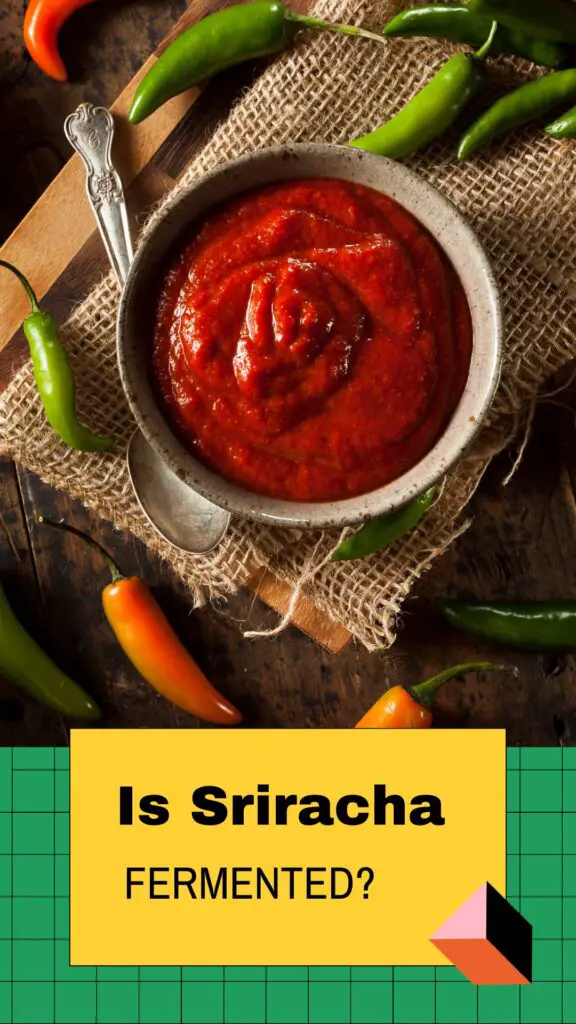We all love Sriracha sauce for its spicy, tangy flavor.
But what gives Sriracha its distinctive flavor among a sea of other hot sauces? Fermentation?
In this article, we will take a closer look at the process of making sriracha and see whether or not fermentation is a part of it, and if yes, the role it plays and why it is important.
We will also discuss the benefits of fermented foods and why you might want to choose a fermented sriracha sauce.

Is Sriracha Made From Fermented Peppers?
The process of making Sriracha sauce can vary, and whether or not it contains fermented peppers depends on the specific technique employed and the brand producing it.
While some recipes do indeed incorporate fermented peppers in order to develop a deep, complex flavor profile and increase the sauce’s longevity, many commercial brands tend to skip this step.
Preservation and consistency in this case, are often maintained through the use of additives and preservatives.
However, if you’re searching for a Sriracha sauce with fermented peppers, you’ll want to look at artisanal or small-batch offerings.
Brands like Wildbrine Probiotic Sriracha Sauce stand out as one such example.
This brand prides itself on using fermentation in their methods and includes live cultures in their product while avoiding added sugars.
Why Is Sriracha Fermented? And For How Long?
The fermentation process used in some Sriracha sauce recipes plays a crucial role in determining the final taste, texture and longevity of the sauce..
Fermentation brings depth and complexity to the sauce’s flavor profile.
By allowing natural bacteria to break down sugars in the peppers, it imparts a sour or tangy note which balances out the natural heat of the peppers.
This process also extends the shelf life of the sauce by creating an acidic environment that inhibits harmful bacteria.
The duration of fermentation can vary significantly when it comes to Sriracha, with different recipes recommending different lengths of time.
Some suggest a shorter fermentation period of 3-5 days, while others advocate for a full week.
No matter the suggested fermentation time, one thing remains true: the longer Sriracha is allowed to ferment, the more intense and complex its flavors become.
Is Huy Fong Sriracha Fermented?
Huy Fong’s Sriracha is indeed a fermented food product.
Its recipe includes red peppers, vinegar, garlic, sugar and salt.
Once the peppers have been sourced from growers and ground into a thick paste, this puree is combined with vinegar and garlic and left to ferment which causes a breakdown of the natural sugars present in the pepper to produce lactic acid and carbon dioxide which contribute heavily to Sriracha’s unique flavor profile.
Is Tabasco Sriracha Fermented?
Tabasco’s Sriracha doesn’t undergo fermentation.
Instead, one of its key ingredients is the famous Tabasco Brand Pepper Sauce which itself is a fermented concoction.
This sauce uses peppers that have been aged up to three years in barrels, which helps to add that unique tabasco flavors through its own fermentation process.
Even though the sriracha sauce as a whole isn’t fermented, because it contains Tabasco Brand Pepper Sauce, it does have hints of the complex flavors that come from fermentation.
The aging of the pepper sauce does introduce depth and character into the finished Sriracha product.
Which Other Sauces Aside from Sriracha Are Fermented?
Huy Fong’s version isn’t the only version of sriracha that is fermented. There are various other sauces around the world that also rely on this age-old technique for flavor.
Let’s explore some of them.
Tabasco Pepper Sauce
Starting off our global travel in Avery Island, Louisiana, we encounter Tabasco Pepper Sauce – an iconic name in hot sauces worldwide.
Known for its fiery heat and distinct flavor profile, Tabasco sauce is indeed a product of fermentation.
The process begins with tabasco peppers which are ground into a mash.
This mash is then combined with salt and left to ferment in oak barrels for up to three years!
Only after this extensive aging period does the pepper mash achieve its unique piquant tanginess that Tabasco is known for.
Harissa Sauce
Now let’s pack our bags and head over to North Africa for our next sauce: Harissa.
Though recipes can vary drastically from one region or household to another in Northern African countries like Tunisia, Libya & Algeria; most traditional harissa recipes involve fermentation.
The base ingredient of harissa is chili peppers (usually smoked), blended with garlic, coriander seeds, caraway seeds and sometimes tomatoes.
This blend is then allowed to ferment before olive oil is added for preservation purposes.
The result?
A deliciously hot yet flavorful sauce that adds depth to tagines, couscous dishes and more.
Gochujang Sauce
Lastly, we journey over to South Korea where Gochujang holds sway.
Gochujang is a savory, spicy and pungent fermented Korean condiment made from red chili powder, glutinous rice powder (also known as sweet rice or sticky rice), powdered fermented soybeans called meju powder and salt.
The mixture ferments anywhere between months to years resulting in a thick paste that adds a quintessential kick to traditional Korean dishes like Bibimbap and Bulgogi.

